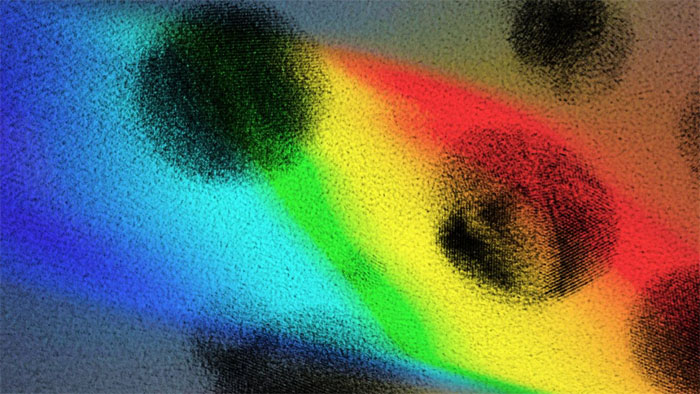
Enhanced Photosensors Exploit Wavelength-Shifting Properties of Nanoparticles
Scientists at the U.S. Department of Energy’s (DOE) Argonne National Laboratory are using nanotechnology to improve the ability of photodetectors to handle the UV radiation produced in high-energy physics experiments.
Physicists explore basic properties of neutrinos and dark matter through interactions with noble elements. In response to interactions with high-energy particles, these elements emit scintillation photons in the UV range. However, most available detectors have poor response in the UV so it is typically necessary to shift UV to a wavelength matching the sensitivity of the detector.

In this artist's rendering, ultraviolet light is converted by nanoparticles (black dots) into visible light. Different size nanoparticles will shift light into different wavelengths, or colors. Courtesy of Argonne National Laboratory.
The Argonne team, in collaboration with researchers at the University of Texas at Arlington, applied coatings of different types of nanoparticles to conventional photodetectors. Several nanoparticle coatings were tested for absorption of UV light with subsequent emission in the visible wavelength.
The enhanced photodetectors demonstrated significantly greater sensitivity to UV light than the coating-free photodetectors across a range of varying compositions. Smaller nanoparticles were found to absorb shorter wavelengths, which were then emitted as longer wavelengths with less energy — a transition known as the Stokes shift. Several nanoparticle types exhibited enhanced detection for wavelengths in the range 200 to 320 nm. Various nanoparticle concentrations were tested to optimize the concentration for the best outcome.
The researchers believe that since the size of the nanoparticles determines the wavelength range of the shifted light, a nanoparticle wavelength-shifter could be tuned to match the optimal sensitivity of an existing photodetector. An optimal photodetector for a specific physics process would then consist of a type-selected nanoparticle coating or infusion in a substrate, with the nanoparticle size set so that the Stokes-shifted emitted light would match the peak sensitivity of a chosen photodetector.
The research indicates that ZnS:Mn,Eu; ZnS:Mn; Cu-Cy; CdTe; and LaF3:Ce nanoparticles have good potential for high-energy particle detection.
By enhancing photodetectors’ sensitivity to any UV signal that is produced, however small, the nanoparticle coatings could increase the chances of detecting rare events, and could give scientists a better view of the phenomena that constitute the building blocks of our universe.
“We’re always looking to find better materials that will allow us to detect our particles,” physicist Stephen Magill said. “We'd like to find a single material that will allow us to identify a specific particle and not see other particles. These nanoparticles help get us closer.”
The advantages of the nanoparticle coatings could extend beyond the purview of particle physics. Magill suggested that the particles could be incorporated into a transparent glass that could enhance the amount of visible light available in some dim environments.
“There’s a lot of light out there between 300 nanometers and 400 nanometers that we don’t see and don’t use,” Magill said. “By shifting the wavelength, we could create a way for that light to become more useful.”
The research was published in Scientific Reports (doi:10.1038/s41598-018-28741-y).
Published: September 2018